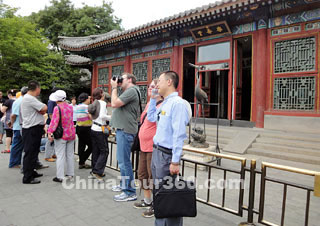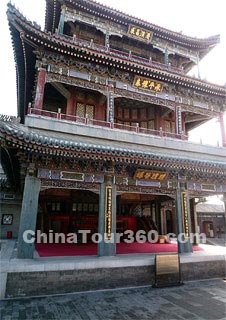The Imperial Living Area in Summer Palace is located behind the Hall of Benevolence and Longevity, towards the northern side of Kunming Lake’s east bank. The main buildings of this area are the Hall of Happiness and Longevity (Leshou Tang), Hall of Jade Ripples (Yulan Tang) and Yiyun Hall (Yiyun Guan) where Empress Dowager Cixi, Emperor Guangxu and his wife Empress Longyu had ever lived. Together with the Longevity Chamber (Yongshou Zhai), Wind of Virtue (Yangren Feng) and Garden of Virtue and Harmony (Dehe Yuan), they make up the entire Imperial Living Area.
 |
| Hall of Happiness and Longevity |
![]() Hall of Happiness and Longevity (Leshou Tang)
Hall of Happiness and Longevity (Leshou Tang)
Originally built in 1750 during the reign of Emperor Qianlong in the Qing Dynasty (1368 - 1644), the Hall of Happiness and Longevity was built by Emperor Qianlong for his mother’s birthday. It was damaged in 1860 and restored in 1887. Thereafter, it was made as the dwelling place for Empress Dowager Cixi in the Summer Palace. The Hall faces the Kunming Lake, backs onto the Longevity Hill (Wanshou Shan), adjoins the Hall of Benevolence and Longevity (Renshou Dian) in the east, and meets the Long Corridor in the west. It is the best place in the Summer Palace for living and entertainment. It is also the most luxurious palace and the first place to have electric bulbs in the Summer Palace.
![]() Hall of Jade Ripples (Yulan Tang)
Hall of Jade Ripples (Yulan Tang)
The Hall of Jade Ripples, constructed in 1750, is a building complex having a courtyard enclosed in three directions. The main hall, one of the most significant historical sites in the Summer Palace, faces south and was once the study of Emperor Qianlong. Emperor Jiaqing had ever handled state affairs, had meals, and summoned his ministers here, too. Emperor Guangxu was confined in this hall by Empress Dowager Cixi after the failure of the Hundred Days’ Reform.
![]() Yiyun Hall (Yiyun Guan)
Yiyun Hall (Yiyun Guan)
Yiyun Hall precisely faces the back door of the main hall of the Hall of Jade Ripples. 'Yiyun' means collection of books. The hall was built in 1750 as the dwelling place for Empress Longyu in the Summer Palace. The furniture articles inside the hall are all rare treasures inlayed with gems and bamboo filaments.
![]() Wind of Virtue (Yangren Feng)
Wind of Virtue (Yangren Feng)
Wind of Virtue, built during the reign of Emperor Qianlong, is a small garden at the northwestern corner of the Hall of Happiness and Longevity. In the front of the garden is a moon-shape doorway, crossing which there is a square pool. At the back of the pool is a lawn where one will find, on which there were originally five Buddhist rooms. Every item in the garden resembles a fan, such as windows, thrones in the hall, imperial desks and palace lanterns. Therefore, it is also known as 'Fan-shape Hall'.
![]() Longevity Chamber (Yongshou Zhai)
Longevity Chamber (Yongshou Zhai)
Longevity Chamber was once the living place of the most powerful eunuch Li Lianying during the period of Empress Dowager Cixi. It is even larger than the Hall of Jade Ripples where Emperor Guangxu lived. The chamber is situated on the north side of the Hall of Happiness and Longevity, commonly known as Courtyard of the Head Eunuch. According to the imperial rules of the Qing Dynasty, a eunuch was not able to live in a principal room. Nevertheless, relying on the great favor by Empress Dowager Cixi, Li Lianying didn’t only live in a principal room, but he was also given a large courtyard. Nowadays, there are three exhibition rooms in the chamber, displaying the emergence and evolvement of the eunuch in China and the Li Lianying’s life here.
![]() Garden of Virtue and Harmony (Dehe Yuan)
Garden of Virtue and Harmony (Dehe Yuan)
Being an area for living, the Imperial Living Area was of course built with entertainment and leisure facilities, such as the Garden of Virtue and Harmony. The garden, to the north of the Hall of Benevolence and Longevity (Renshou Dian), was built upon the site of the Yichun Hall during the reign of Emperor Qianlong (1336 - 1795). Later, it was reconstructed during the governance of Emperor Guangxu (1875 - 1908). The main buildings here are the Grand Stage (Daxilou), the Hall of Health and Happiness (Yikedian) and Hall of Celebrating Virtues (Qingshantang), which were the place for Empress Dowager Cixi to enjoy operas.
 |
| Grand Stage |
![]() Grand Stage
Grand Stage
The Grand Stage is the largest and best-preserved ancient opera stage in China. The stage, together with Belvedere of Pleasant Sounds (Changyinge) in Forbidden City and the Pavilion of Clear Sound (Qingyinge) in Chengde Summer Resort, are reputed as the 'Three Grand Opera Stages of the Qing Dynasty'. This stage was built for Empress Dowager Cixi’s 60th birthday and exclusively for her to watch operas. With a height of 21 meters (69 feet), it is the second highest building in the Summer Palace, just second to the Tower of Buddhist Incense (Foxiangge). It is a three-storey building, with a two-storey auxiliary building behind for the performers to prepare. On its ceiling, there are seven 'Sky Wells', and on the ground, there are 'Ground Wells'. At the bottom of the stage there are wells and five squared pools. When a ghost show was performed, the performer might either descend from the 'sky' or ascend from the 'ground'. Its construction brought a tremendous boost to Peking Opera, so it was praised as 'the Cradle of Peking Opera'.
![]() Hall of Health and Happiness (Yile Dian)
Hall of Health and Happiness (Yile Dian)
The Hall of Health and Happiness, opposite to the Grand Stage, was especially built for Empress Dowager Cixi to watch the operas. On its eastern and western sides, a total of 19 opera-viewing lounges were built along, which were for those nobles and officials watch the operas.
![]() Go to the Next Scenic Area: Kunming Lake Area
Go to the Next Scenic Area: Kunming Lake Area








